Antibody data
- Antibody Data
- Antigen structure
- References [1]
- Comments [0]
- Validations
- Western blot [2]
- Immunohistochemistry [1]
- Flow cytometry [2]
- Other assay [1]
Submit
Validation data
Reference
Comment
Report error
- Product number
- PA5-24865 - Provider product page

- Provider
- Invitrogen Antibodies
- Product name
- MFAP4 Polyclonal Antibody
- Antibody type
- Polyclonal
- Antigen
- Synthetic peptide
- Description
- This antibody is predicted to react with bovine based on sequence homology.
- Reactivity
- Human, Mouse
- Host
- Rabbit
- Isotype
- IgG
- Vial size
- 400 μL
- Concentration
- 0.5 mg/mL
- Storage
- Store at 4°C short term. For long term storage, store at -20°C, avoiding freeze/thaw cycles.
Submitted references TNF antagonist sensitizes synovial fibroblasts to ferroptotic cell death in collagen-induced arthritis mouse models.
Wu J, Feng Z, Chen L, Li Y, Bian H, Geng J, Zheng ZH, Fu X, Pei Z, Qin Y, Yang L, Zhao Y, Wang K, Chen R, He Q, Nan G, Jiang X, Chen ZN, Zhu P
Nature communications 2022 Feb 3;13(1):676
Nature communications 2022 Feb 3;13(1):676
No comments: Submit comment
Supportive validation
- Submitted by
- Invitrogen Antibodies (provider)
- Main image
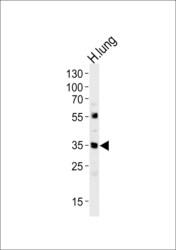
- Experimental details
- Western blot analysis of MFAP4 in human lung tissue lysate. Samples were incubated with MFAP4 polyclonal antibody (Product # PA5-24865) using a dilution of 1:1,000 followed by goat anti-rabbit IgG H&L (HRP) at a dilution of 1:5,000. Lysate at 35 µg per lane.
- Submitted by
- Invitrogen Antibodies (provider)
- Main image

- Experimental details
- Western blot analysis of MFAP4 in mouse lung tissue lysates. Samples were incubated with MFAP4 polyclonal antibody (Product # PA5-24865). Lysates: 35 µg/lane. MFAP4 (arrow).
Supportive validation
- Submitted by
- Invitrogen Antibodies (provider)
- Main image
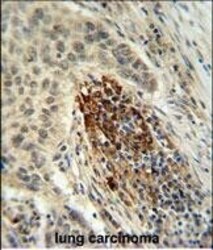
- Experimental details
- Immunohistochemistry analysis of MFAP4 in formalin fixed and paraffin embedded human lung carcinoma. Samples were incubated with MFAP4 polyclonal antibody (Product # PA5-24865) followed by peroxidase conjugation of the secondary antibody and DAB staining. This data demonstrates the use of this antibody for immunohistochemistry. Clinical relevance has not been evaluated.
Supportive validation
- Submitted by
- Invitrogen Antibodies (provider)
- Main image
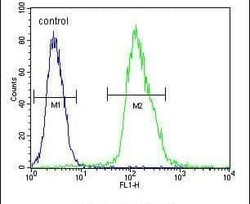
- Experimental details
- Flow cytometry analysis of MCF-7 cells using a MFAP4 polyclonal antibody (Product # PA5-24865) (right) compared to a negative control cell (left) at a dilution of 1:10-50, followed by a FITC-conjugated goat anti-rabbit antibody
- Submitted by
- Invitrogen Antibodies (provider)
- Main image
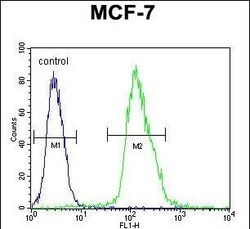
- Experimental details
- Flow cytometry of MFAP4 in MCF-7 cells (right histogram). Samples were incubated with MFAP4 polyclonal antibody (Product # PA5-24865) followed by FITC-conjugated goat-anti-rabbit secondary antibody. Negative control cell (left histogram).
Supportive validation
- Submitted by
- Invitrogen Antibodies (provider)
- Main image
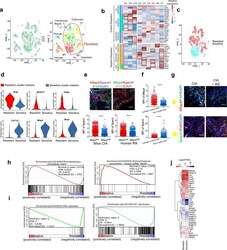
- Experimental details
- Fig. 3 Single-cell RNA sequencing reveals fibroblast subsets with distinct ferroptosis sensitivity. a tSNE plot displaying 4735 CD45- cells from 3 STIA mice separated into 7 major cell types, including fibroblasts (9 clusters), vasculature (2 clusters), pericytes (1 cluster), chondrocytes (1 cluster), muscle cells (1 cluster), osteoblasts (2 clusters), and erythrocytes (2 clusters). b Heatmap showing the expression of high-risk ferroptosis genes in fibroblast clusters in the inflamed STIA joints. c Predicted ferroptosis-sensitive and ferroptosis-resistant fibroblast subsets based on ferroptosis-related genes listed in ( b ). d Expression of identified conserved marker genes in the ferroptosis-sensitive and ferroptosis-resistant fibroblast subsets. e Left, representative fluorescent multiplex IHC staining and quantification of inflamed joints of CIA mice labeled with anti-Mfap4 (red), anti-Sparcl1 (purple), anti-FAPalpha (green), and DAPI (blue). Mfap4 low , n = 9905 cells from 10 inflamed joints. Mfap4 high , n = 3336 cells from 10 inflamed joints. Right, representative fluorescent multiplex IHC staining (top panel) and quantification (bottom panel) of hyperplastic synovium of RA patients labeled with anti-Mfap4 (green), anti-Sparcl1 (red), anti-FAPalpha (orange), and DAPI (blue). Mfap4 low , n = 8222 cells from 10 independent human synovium samples. Mfap4 high , n = 6730 cells from 10 independent human synovium samples. Scale bars, 200 mum. **** P < 0.0001; two-tailed t -tes
 Explore
Explore Validate
Validate Learn
Learn Western blot
Western blot